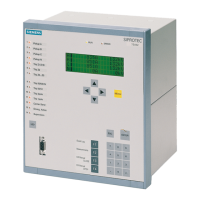Functions
2.3 Differential Protection
SIPROTEC, 7SD610, Manual
C53000-G1176-C145-6, Release date 02.2011
65
2.3 Differential Protection
The differential protection is the main function of the device. It is based on current comparison. For this, one
device must be installed at each end of the zone to be protected. The devices exchange their measured quan-
tities via communications links and compare the received currents with their own. In case of an internal fault
the allocated circuit breaker is tripped.
Apart from normal lines, 7SD610 also enables protecting lines with transformers switched en block (order vari-
ant). The protected zone is selectively limited by the CTs at its ends.
2.3.1 Function Description
Basic principle with two ends
The differential protection is based on current comparison. It makes use of the fact that e.g. a line section L
(Figure 2-15) always carries the same current i (dashed line) at its two ends in healthy operation. This current
flows into one side of the considered zone and leaves it again on the other side. A difference in current is a
clear indication of a fault within this line section. If the actual current transformation ratios are the same, the
secondary windings of the current transformers CT1 and CT2 at the line ends can be connected to form a
closed electric circuit with a secondary current I; a measuring element M which is connected to the electrical
balance point remains at zero current in healthy operation.
When a fault occurs in the zone limited by the transformers, a current i
1
+ i
2
which is proportional to the fault
currents I
1
+ I
2
flowing in from both sides is fed to the measuring element. As a result, the simple circuit shown
in Figure 2-15 ensures a reliable tripping of the protection if the fault current flowing into the protected zone
during a fault is high enough for the measuring element M to respond.
Figure 2-15 Basic principle of the differential protection for a line with two ends
Transmission Measured Value
If the entire protected object is located in one place — as is the case with generators, transformers, busbars
— the measured quantities can be processed immediately. This is different for lines where the protected zone
spans a certain distance from one substation to the other. To be able to process the measured quantities of all
line ends at each line end, these have to be transmitted in a suitable form. In this way, the tripping condition at
each line end can be checked and the respective local circuit breaker can be operated if necessary.
7SD610 transmits the measured quantities as digital telegrams via communication channels. For this, each
device is equipped with one protection data interface.
Figure 2-16 shows this for a line with two ends. Each device measures the local current and sends the infor-
mation on its intensity and phase relation to the opposite end. The interface for this communication between

